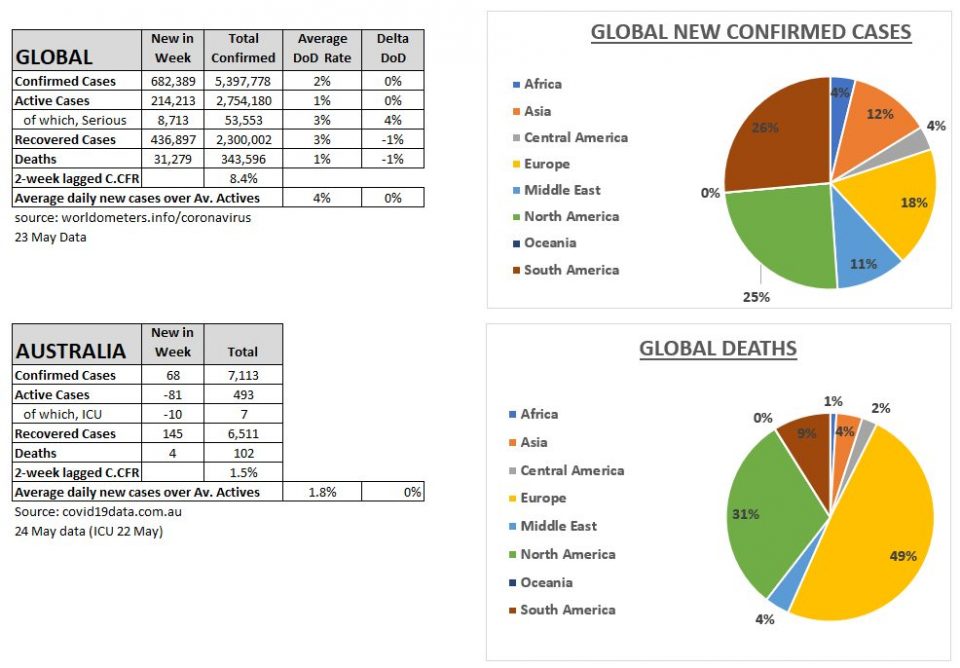
Covid-19 Blog
COVID-19 Weekly Roundup 25 May 2020
In today’s roundup, we take a look at global confirmed cases – now passed five million – and the several new cases in Australia that are mostly linked to known sources. There has also been some positive progress in the development of a COVID-19 vaccine and some new research linked to Vitamin D deficiency.

World Summary – 23 May
- Confirmed cases passed five million and active cases passed 2.75 million.
- Brazil has become the second largest outbreak, ahead of Russia. USA remains the largest with 31% of global confirmed cases but their share of new cases is slowly falling. Eleven (+2 Peru, India) other countries have outbreaks of 100,000+ and a further 36 (+0) countries have outbreaks of 10,000+.
- Of the outbreaks over 10,000, Mexico’s is the fastest growing. Mexico, Chile, South Africa, Iran and Brazil all had average daily new case rates of 10% or more.
- 13 countries reported new cases of over 10,000 headed by the USA, Brazil, Russia and India. These 13 countries account for 78% of the reported new cases, with the four ‘leaders’ accounting for 56% of the global total.
- Central America and Southern Africa are the fastest growing regional outbreaks with a growth rate of over 10%, dominated by Mexico and South Africa respectively.
- Growth in both new and active cases is slowing, but the number of new cases still outstrips new recoveries. USA still dominates active cases, with 41%. The next three, Russia, Brazil and the UK* account for another 21% (*UK estimated).
- The rate of deaths slowed marginally. USA, UK, Italy, Spain, France and now Brazil, account for 62% of deaths. C.CFRs for UK, Spain, Italy and France are high (10%~16%) and moderately high(6%) for USA and Brazil.
Australia Summary – 24 May
- Weekly new cases were dominated by Victoria’s 55 (-24) new cases. NSW had 16 (-7) , Queensland 5 (+3), and SA, ACT, WA, Tasmania and NT had no new cases.
- Queensland’s experience points to the difficulty of locating and containing all infections, while Victoria’s recent experience points to how infectious COVID-19 remains, with numbers linked largely to one localised outbreak.
- Daily tests have fallen to over 25,000 with the rate of positives under 0.05%.
- Infections are reasonably uniform across ages other than for the under 10’s, but the median age of deaths (where age has been reported) is in the 80s.
- Most new cases this week were from quarantined incoming overseas arrivals, followed by known sources of local infections. 11 cases this week had an unknown transmission source.
Key market updates
- Australia’s AAA credit rating has been reaffirmed by Fitch in an expression of confidence in the Morrison Government’s handling of the coronavirus crisis. The outlook has however moved to negative from stable.
- S&P turned their outlook to negative on global reinsurance, with rising property and casualty claims and falling investment returns. However, A.M. Best predict that most insurers and reinsurers can withstand the COVID-19 shock to their balance sheet.
- Pandemic exclusions within business interruption insurance continue to be tested, both locally and overseas.
- APRA has released an FAQ for market-risk capital providing guidance to authorised deposit-taking institutions in determining their capital requirements under APS 116 Capital Adequacy: Market Risk.
- APRA data on the superannuation early release scheme, shows payments of $9.0bn and over 1.3m applications received to date.
New COVID-19 research this week
- Vaccines by US-based Moderna and Chinese-based CanSino have both been shown to be safe and produce antibodies to the virus in Phase one trials in humans. UK-based Astra Zeneca / Oxford University’s combined Phase one and two trial is expected to report shortly, and the US has already ordered more than 300 million doses. More than 100 vaccines are under development, and ten have begun human testing. All vaccines will need Phase two trials to test dosage, and Phase three trials in larger human populations. Some experts predict fast-tracking could see vaccine production as early as September.
- Chloroquine and hydroxychloroquine, the drug being taken by US President Donald Trump, increased mortality in a study of 96,000 patients hospitalised with COVID-19. It is still being tested to see if it is effective as a prophylaxis to prevent infection.
- Vitamin D deficiency has also been linked to poorer outcomes of COVID-19.
- Placing masks close to hamsters infected with COVID-19 reduced infection in healthy hamsters by up to 75%. This adds to strong observational data that masks are effective. Almost 90% of the world’s population live in countries where masks are required or recommended. The WHO recommends health care workers and people with suspected COVID-19 wear masks, and that they be considered for people who are high risk, in high-contact roles or where social distancing isn’t feasible
- Across 24 European countries there were 140,000 excess deaths compared to previous years between March 16 and April 26. This is higher than official COVID-19 death counts, suggesting official counts may be an underestimate.
- There will likely be some influence of winter on the spread and severity of COVID-19, as lower humidity and air temperature can increase the viability and virulence of the virus and therefore its infectivity. However, public health interventions like restriction of mass gatherings and social distancing were shown to have far greater effect through multi-variate analysis and pandemic modelling.
- A range of models forecasting the COVID-19 pandemic were released this week, including research showing that 36,000 deaths in the US could have been prevented if lockdown measures had been put in place seven days earlier, and alternative modelling scenarios as Australia comes out of lockdown. Want to try modelling your own pandemic? Here’s a great tool from the Actuarial Society of South Africa.
- Australian parents have been consuming more alcohol more frequently during the lockdown, with parents of primary-school aged children most likely to be drinking the most. In the UK, there are concerns reduced physical activity during lockdown will exacerbate illness in those with chronic conditions.
- By early April, daily CO2 emissions had fallen by 17% globally compared to 2019 levels due to lockdowns imposed around the world. This is the sharpest drop in carbon output since records began.
New on the Actuaries Institute website this week.
- Actuaries Digital article – COVID-19: Scenarios for Australia pre and post lockdown by Matthew Tiong
- Podcast – Actuaries Institute’s response to COVID-19 featuring Jennifer Lang and John McLenaghan
This work is licensed under a Creative Commons Attribution-NonCommercial-No Derivatives CC BY-NC-ND Version 4.0.
CPD: Actuaries Institute Members can claim two CPD points for every hour of reading articles on Actuaries Digital.






